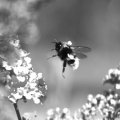Pecan nut research at the University of Queensland's Gatton College is extending shelf life by discovering the cause of 'bruising' which speeds up the natural rancidity process.
Food Science and Technology PhD student Lara Wakeling has examined the composition of the native American nuts to help solve the problem which affects up to 70 percent of Australia's pecan crop.
The project is funded by the Horticultural Research Development Corporation (HRDC) and Stahmann Farms Australia.
Pecans, which have an oil content of about 70 percent, were introduced on a commercial basis to Australia from America in 1969 with the largest producers now based in Moree in New South Wales. Australian pecans do not have any natural pests and produce among the highest yields in the world.
Ms Wakeling said her pecan research was the first Australian-based study.
'Normally pecans have a purely white interior and what I found was the interior of some nuts was brown and oily-looking . We have called this condition opalescence,' Ms Wakeling said.
'The problem has become evident in Australia over the past eight to 10 years and has also been recognised in the United States.'
The bruising was evident only when the nuts were broken open, Ms Wakeling said.
'Because pecan nuts have a high oil content, they have naturally tend to go rancid, reducing their shelf-life. In opalescent pecans rancidity develops much faster,' she said.
'The problem for both consumers and producers is to ensure the nuts are stored under the right conditions to delay the onset of rancidity.'
Ms Wakeling said her research found the cause of the nuts' opalescence was due to two factors - a lower than normal calcium level and a higher than normal oil content.
'Calcium is important in retaining cell wall integrity so a lower calcium content means cell walls are likely to be weaker. Because the nuts have a high oil content, they are literally just bursting at the seams.
'Processing, which is really just cracking, sorting and packing the nuts, places a great deal of stress on pecans and particularly on pecans with high oil and low calcium content, causing their oil bodies to fall apart and spill, producing opalescence.'
Ms Wakeling said her study had found the opalescence was also influenced by horticultural factors.
'The producers need to look at a way of increasing the calcium content and decreasing the oil content to create a balance within the pecans,' she said.
Ms Wakeling said it was not yet known whether the Australia-wide problem was caused by a general deficiency in the soil or stress from the high yields being produced.
Ongoing study until the end of the year was examining whether the maturity of the nuts also affected opalescence levels, she said.
'If we discover that immature nuts have a lower opalescence, we need to know if those nuts are still acceptable to the consumer,' she said.
Ms Wakeling said the ideal storage conditions for pecans was at zero degrees Celsius for up to six months.
'All nuts should be stored in the refrigerator, and preferably the freezer. Nuts are full of oil and as soon as they are left at room temperature the rate of rancidity increases,' she said.
'And although pecans have a high oil content, this is composed mainly of unsaturated fatty acids and they are quite healthy to eat - as part of a well-balanced diet of course.'
For information contact Lara Wakeling (telephone (07) 3365 0141).



